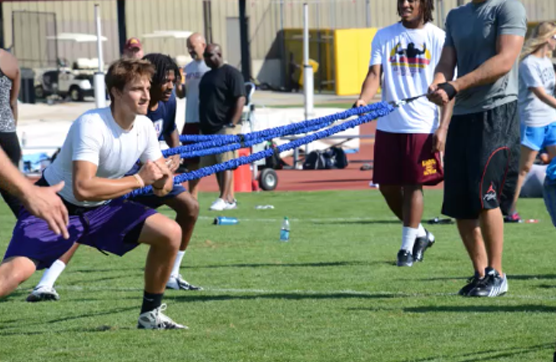Lateral Training for Improving Forward Sprinting Velocity

Lateral Training for Improving Forward Sprinting Velocity
By Dan Hutchison, MS, ATC, CSCS
The running motion predominantly occurs in the sagittal plane, which is the plane in which forward and backward movements of the body and body segments occur. So why should we talk about ‘lateral training’ with forward sprinting velocity? Many muscle groups associated with optimal forward sprinting can be stimulated during lateral training exercises, and may provide some important activation and adaptation characteristics to improving forward running velocity. Specific aspects of the running stride recruit muscles that will optimize forward propulsion. If we can activate and prepare these muscles in not only the specific running phase, but also through other various movements, the body will be better prepared to utilize these muscles and also reduce the chances of injuries.
The running stride is made up of 3 fundamental phases – stance, swing, and push off. These phases can be broken down more, but we will stick with a basic approach and look into lateral training and how it affects the swing and stance phases. We will also look at two specific joints, the ankle and hip, and three key aspects of these joints that lateral training can improve.
The first area where lateral training can improve forward velocity is by enhancing lateral hip stabilization during the stance phase of running. The Gluteus Medius muscle functions to stabilize the pelvis during the support/stance phase of walking or running, while also contracting to support the opposite limb during swing mechanics. Stability training involving single-leg balance variations, strength work, and dynamic lateral movement drills adequately stimulate the glute medius and allow those muscles to properly stabilize the pelvis during loaded situations. Some examples of drills to improve lateral hip stabilization:
- Single-Leg balance drills progressing from a stable surface to an unstable surface.
- Single-Leg strength exercises – Lunge walk, split-squat, single-leg Romanian deadlift (SLRDL), and hip abduction.
- Dynamic lateral movement drills – Resistance cord applications (Flex-X™ Lower body trainer/Speed-X™ Lower Body Training System), lateral shuffles, Carioca, lateral bounding.
The second area that improves forward running velocity through lateral training is ankle stability. Kinetically, by strengthening the hip area first, the ankle joint will adapt through ancillary muscle feedback, and be better ‘protected’ during athletic movement. The ankle joint has four distinct movements – plantar flexion, dorsi flexion, inversion and eversion. The movements of inversion and eversion are very small but provide medial-lateral stability to the ankle throughout the stance phase of forward running (i.e., touch down and push off). Inversion is the sole of the foot turning inward (medial); eversion is the sole of the foot turning outward (lateral). Lateral training applications improve the stability of the ankle by challenging these movements under a specific load (e.g., bodyweight, dynamic movements, resistance training). Lightly loading these movements create stability in the ankle joint during the stance phase, and can prevent excessive movement via supination or pronation within the foot during the running motion. Because the foot is so inundated with bones, tendons, cartilage and fascia, lateral training applications also provide ‘soft tissue’ training adaptations that can act as protectors of the foot during athletic movement at high velocities. Some examples of drills to improve medial-lateral ankle stabilization:
- Single-Leg balance drills progressing from a stable surface to an unstable surface.
- Progressive cord resisted movements in all planes of motion.
- Single-Leg strength exercises – See above drills for the hip, along with calf raises and dorsi flexion drills.
- Dynamic lateral movement drills – Resistance cord applications (Flex-X™ Lower body trainer/Speed-X™ Lower Body Training System), lateral shuffles, Carioca, lateral bounding.
- Plyometric drills (double-leg to single-leg) – Pattern drills, barrier and box jumps, cord-loaded applications.
The third area of interest for improving forward running velocity through lateral training is flexibility and strengthening of the adductor musculature. The adductors ‘adduct’, or pull the leg toward the midline of the body. The adductors are highly active during the swing phase of sprinting while the hip is going into flexion. Lateral training provides additional stimulation to these muscle groups through flexibility, stability, and dynamic movement. The forceful flexion and extension of the hip require a high level of medial support to properly position the limb prior to touch down. If this positioning is off, the pelvis, knee and foot can be exposed to abnormal impacts at foot strike. By working and training in the frontal plane, the adductor muscle group is properly stimulated for sagittal plane performance. Some examples of drills to improve adductor muscle group strengthening for forward sprinting velocity:
- Strength exercises – Wide-stance squat, lunge walk, hip flexion, and hip adduction.
- Dynamic lateral movement drills – Resistance cord applications (Flex-X™ Lower body trainer/Speed-X™ Lower Body Training System), lateral shuffles, Carioca, lateral bounding.
- Mid-section and core training
Lateral training can be an important factor for improving forward sprinting velocity. Specific muscle groups that enhance performance can be adequately stimulated to stabilize, activate and protect certain soft tissue structures throughout the complex phases of running. Hip strengthening and dynamic movement exercises can be stimulated through body weight, traditional weight, and dynamic resistance applications. Consistent training in this area complements traditional practices for improving forward sprinting performance, and may also play a role in reducing the chances of injury while performing high velocity movements.
References:
Arnheim, D. D. and Prentice, W. E. (1997). Principles of Athletic Training. McGraw-Hill Higher Education.
Hall, S. (2007). Basic Biomechanics. McGraw-Hill Higher Education
Powers, S.K. and Howley, E.T. Exercise Physiology: Theory ad Application to Fitness and Performance (7th Ed.). Boston, MA. 2009.